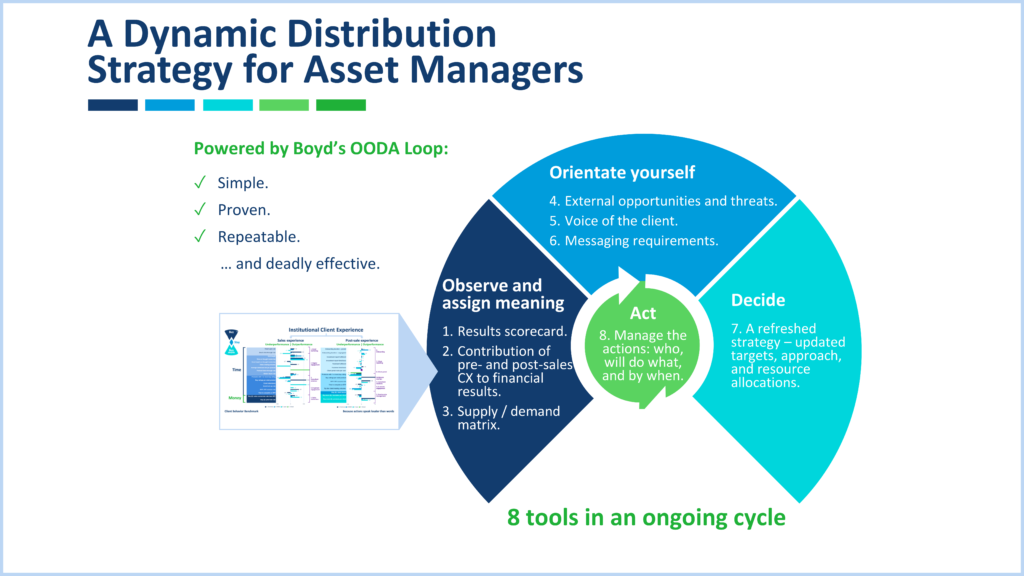In brief
Led by the Head of Distribution (or equivalent), the Distribution Leadership Team (DLT) is responsible for navigating the organization to the sweet spot where ‘what clients are buying’ intersects with ‘what they will buy from you’.
It is a moving target in a changing landscape where only the most adaptable should expect to survive – “responding too slowly results in disorientation, confusion, and further disablement.”
To help DLTs win, Accomplish’s latest playbook is a blueprint for a Dynamic Distribution Strategy for asset managers so they can hit a moving target again and again – harnessing vital lessons fighter pilots have learned about battling for supremacy in ‘winner takes all’ situations. You can download it on this page.
A Distribution Leadership Team must hit a moving target in a changing landscape
Led by the Head of Distribution (or equivalent), the DLT is a cross-functional grouping that typically comprises the heads of specialist areas (product, marketing, sales, and client service) and general capabilities (client insights and strategy / COO).
Collectively, the DLT is responsible for navigating the organization to the sweet spot where ‘what clients are buying’ intersects with ‘what they will buy from you’.
Navigation comprises the planning and execution of a move from one place to another. Successful navigation typically involves adapting the plan incrementally along the way in response to changed conditions. For example, if you are navigating a boat, you may have to adjust to changes in wind direction or crew constraints.
“Responding too slowly results in disorientation, confusion, and further disablement.”
John Boyd

For a DLT, sources of change include long-term trends like commoditized investment performance and cheap substitutes as well as unexpected market events, actions by your competitors, and short-term turbulence (like a fund manager departure). In an over-supplied market, if the DLT underperforms, clients will give their time to your competitors … and then their money.
Two things complicate the situation further: 1) your target (the intersection) will move because, like you, clients are also buffeted by their own external conditions; and 2) in business, unlike in a boat race, there is no final destination where you can rest and relax.
As we demonstrate in the final section, those who respond too slowly to changes “will become disoriented, which will surprise and confuse them, disabling them further.” DLTs, therefore, need a distribution strategy that helps asset managers hit a moving target in a changing landscape.
Darwinism: only the most adaptable should expect to survive
Darwinism teaches us that adaptability is vital because “it is not the strongest that survives (think of an asset manager), nor the most intelligent (think of an asset manager). Rather, it is the one that is the most adaptable to change (think of your own firm).”
What makes a person adaptable? According to Forbes (2015), Goodwin University (2020), and The Forage (2023), four characteristics are essential to adaptability: resilience, critical thinking, collaboration, and responsiveness. The playbook analyses them in detail.
“The one that is the most adaptable survives.”
What makes a DLT adaptable? These attributes are not inherent, though, but can be learned and practised. This matters because, at Accomplish, we believe Darwinism will apply to DLTs as much as it does to everything else. But a DLT is not a person. Instead, it comprises multiple individuals and you should expect them to change over time. To win, therefore, DLTs need a simple way to embed adaptability into their BAU processes.
A Dynamic Distribution Strategy for asset managers

This playbook, therefore, proposes the blueprint of a Dynamic Distribution Strategy for asset managers to hit a moving target by harnessing a simple, proven, repeatable, and deadly effective methodology (see the final section).
This is vital because, to win, a DLT needs to keep hitting the sweet spot where ‘what clients are buying’ intersects with ‘what they will buy from you’ and, according to Darwinism, only the winners should expect to survive.
As with Accomplish’s other playbooks, it demonstrates how DLTs can extract even more value from the Client Behavior Benchmark. Indeed, without the Benchmark’s quarterly data on the contribution to your results of your sales funnel and client journey, it is hard for an organization to stay up to date on changes in its [non-investment] performance relative to that of other asset managers.
A blueprint of organizational adaptability
Specifically, the blueprint puts forward a set of 8 tools in an ongoing cycle – 4 of which your Head of Distribution Strategy (or equivalent) should own, with heads of marketing, product, sales, client service, and client insights owning the remainder.
To ensure the DLT’s analysis is coherent and lacks blind spots, it breaks down each tool to examine its objective, owner, data requirements, data source(s), and output.
We recommend reviewing the tools quarterly. Like navigation, a ‘little and often’ approach will keep your strategy fresh and relevant, and will guard against complacency and a sluggish response to external changes. And each time you repeat a process you get better at it, making the methodology self-improving.
As a result, the DLTs that adopt this dynamic approach will remain an asset to their firms and become a sustainable source of competitive advantage.
A simple, proven, repeatable … and deadly effective methodology

In developing the Dynamic Distribution Strategy for asset managers, we have harnessed vital lessons from military fighter pilots who, like the DLT, battle for supremacy in ‘winner takes all’ situations.
The US Air Force’s Colonel John Boyd who trained ‘top gun’ fighter pilots captured these findings in his OODA Loop. His credentials? ‘40-second Boyd’ was renowned for being able to win any aerial battle in less than 40 seconds.
“Those who prevail complete their OODA Loop quickest and most effectively.”
Colonel J Boyd, USAF ‘Top Gun’ Instructor
The trick to his success? Boyd’s OODA Loop is a constantly repeating four-step decision-making cycle: 1) observe and assign meaning, 2) orientate yourself, 3) decide, and 4) act. The result is a learnable framework for operating at a faster tempo than an adversary, and every time you complete a cycle you get better at it.
Conversely, in Boyd’s experience, those who respond too slowly (because they have a long and slow OODA loop like the outside lane on an athletics track) become disoriented as you operate “inside their OODA loop”, creating surprise and confusion that disables them further.
We hope you found this article useful. If you would like to explore how Accomplish’s Dynamic Distribution Strategy for asset managers lets a DLT harness Boyd’s OODA Loop, you are welcome to download the playbook. It is free.
Lastly, if you would like to learn more about the Client Behavior Benchmark that makes the strategy possible, head to that page where you can research the Benchmark fully and book a demo. Or, book your demo rightaway.




